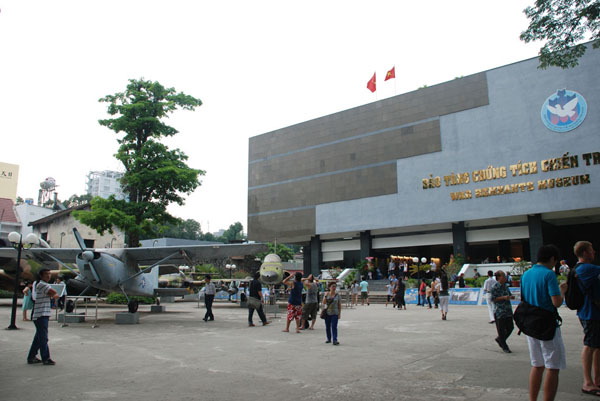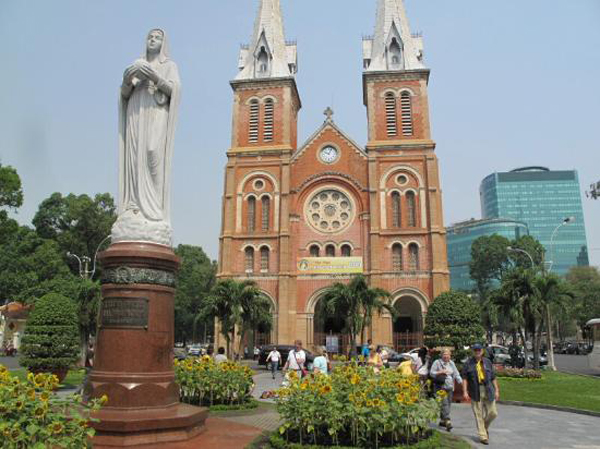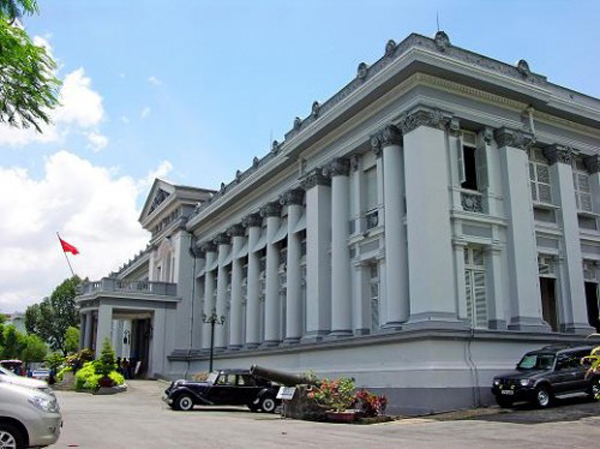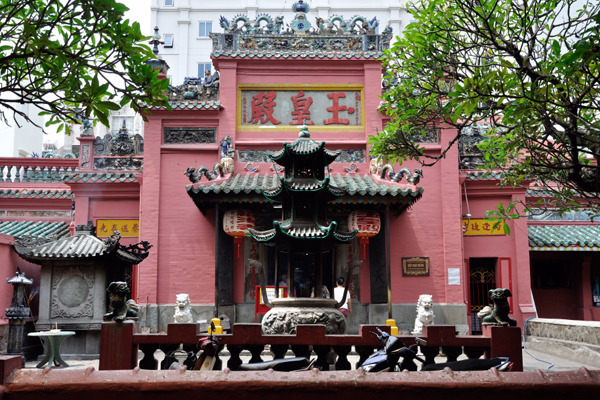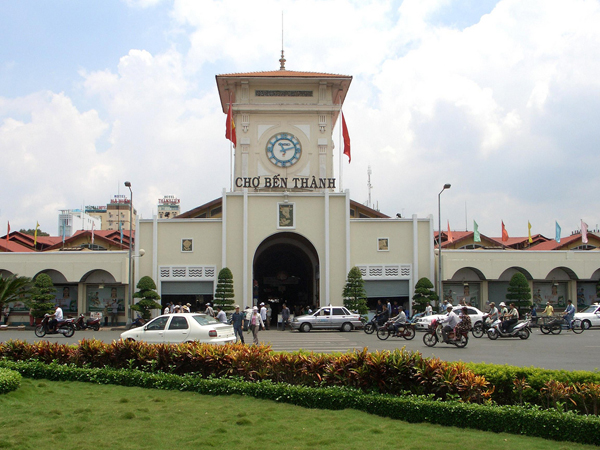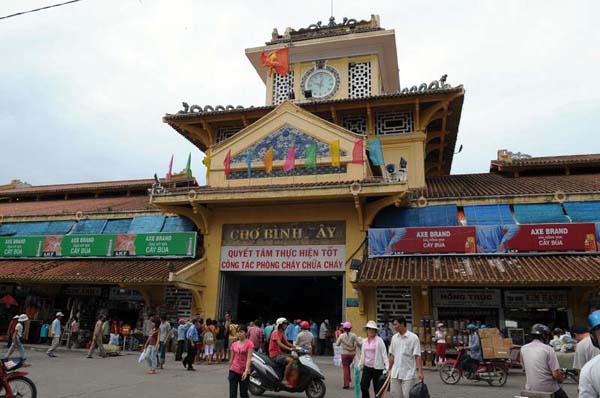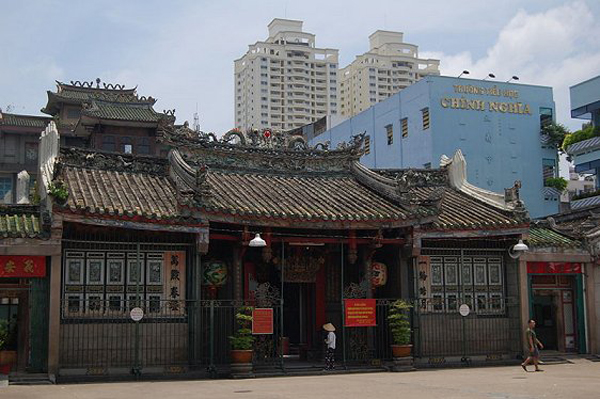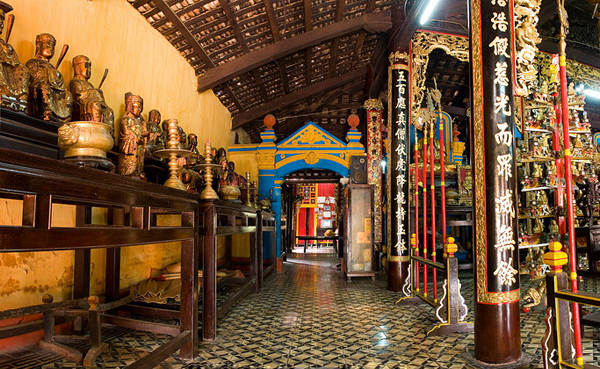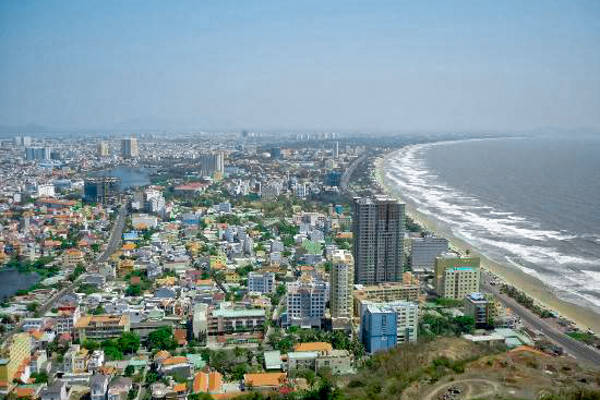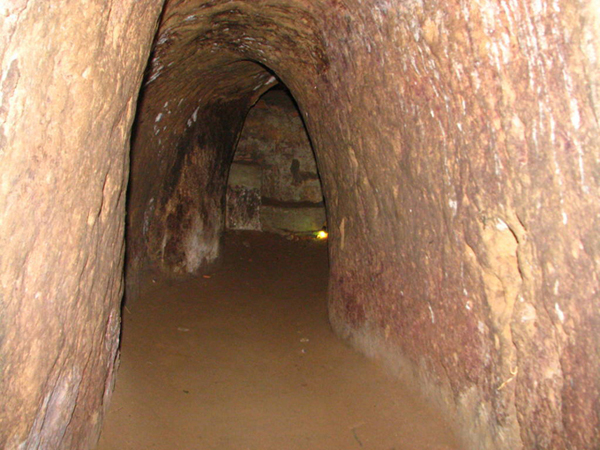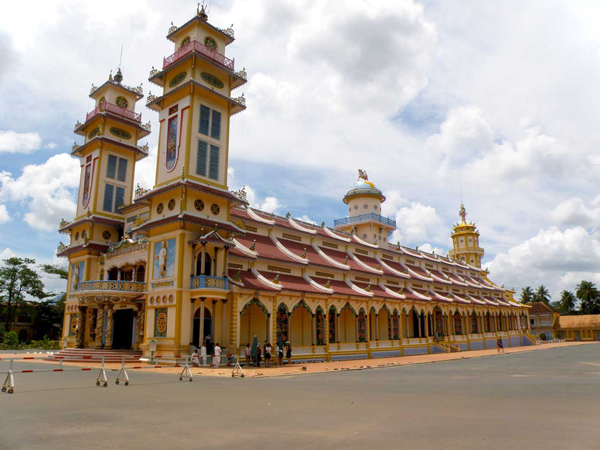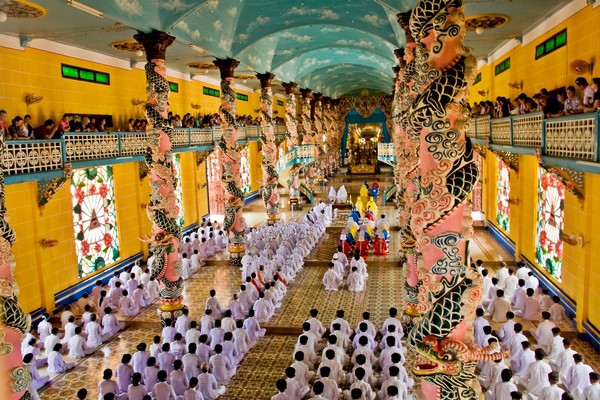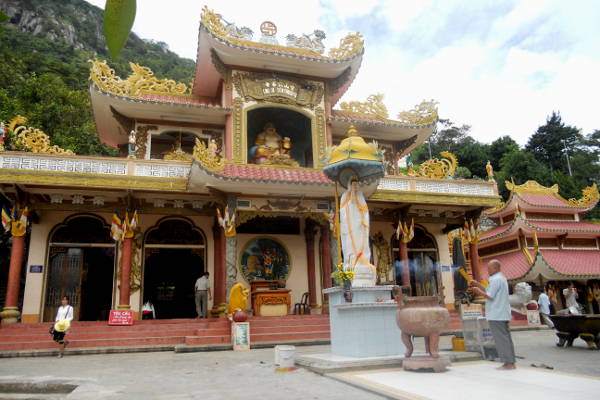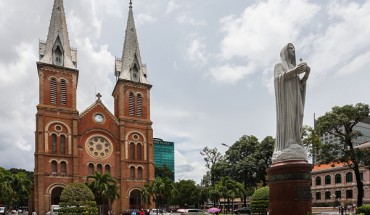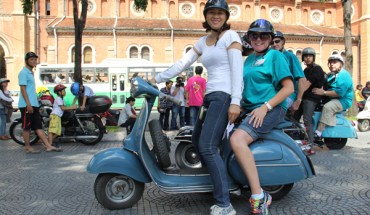Notre Dame Cathedral – Municipal Theatre – War Remnants Museum – Reunification Palace – Military Museum – History Museum – Jade Emperor Pagoda – Xa Loi Pagoda – Ben Thanh Market – Fine Arts Museum
Ho Chi Minh City is newer, larger and brasher than Hanoi. Downtown Saigon is as much a creation of France as of Vietnam, and the city’s colonial style acquired something of a military veneer between 1954 and 1975, when it served as the capital of the US-backed Republic of Vietnam. Today, run-down colonial buildings are being restored and jostle for space with new high-rises.
- Waterfront Area
A good place to start an exploration of the down-town area is the waterfront. Here one can watch the hustle and bustle of the Saigon River as small craft jostle for space with larger ocean-going ships and hydrofoils bound for Vung Tau. Running northwest from the river, busy Dong Khoi Street -known as Rue Catinat under the French and Tu Do during the American years – is the heart of the old French Quarter and leads to Notre Dame Cathedral a towering red-brick structure erected by the French in 1883. A statue of the Virgin Mary stands right in front of the cathedral.
Other colonial buildings worth visiting in the vicinity are the General Post Office, to the east of the cathedral, and the splendid Municipal Theatre (Nha Hat Thanh Pho) on Lam Son Square, built in 1899 and sandwiched between two of Saigon’s most distinguished hotels. The Continental was one of the settings for Graham Greene’s The Quiet American while the Caravelle was where American journalists holed up at during the war. The Continental still retains some of its faded charm while the Caravelle has been renovated into a high-rise, albeit a tasteful one.
At the northern end of Nguyen Hue Boulevard stands the magnificent People’s Committee Building (UBND Thanh Pho). Formerly the Hotel de Ville, dating back to 1908, this was the haunt of reporters and photographers during the war years, as was the adjacent Rex Hotel.
- Revolutionary Museums
Most of Saigon’s museums are downtown, and some merit a visit – though, a quarter of a century after the event, it might be thought that excessive emphasis is placed on the Indochina Wars. The War Remnants Museum (Nha Trung Bay Toi Ac Chien Tranh) at 28 Vo Van Tan (daily 7.30-11.15am and 1.30-5.15pm), manages to combine the tired clichés of communist doublespeak with disturbing exhibits, such as photographs of the My Lai massacre, the effects of chemical defoliants, torture and general brutality. It takes a strong stomach to look at the photographs, but the overall effect is shallow and one-sided.
The Presidential Palace of the former Republic of Vietnam, now called the Reunification Palace (Dinh Thong Nhat), stands at the corner of Nam Ky Khoi Nghia and Le Duan (daily 7.30-11am and 1- 4pm). Built during the 1960s the building is grandiose but architecturally unremarkable. Perhaps the image best associated with it is that of a North Vietnamese tank breaking through the gates on 30 April 1975, symbolizing the downfall of the southern regime and reunification on Hanoi’s terms. The building today houses war memorabilia and lavish but rather tasteless displays of former presidential opulence.
Also rooted firmly in the recent past, the Museum of the Revolution (Vien Bao Tang Cach Mang) at 65 Ly Tu Trong (daily 8-1 lam and l-4pm) provides more evidence of French, US and Chinese duplicity and barbarism. Further northeast is the Military Museum (Bao Tang Quan Doi) on the comer of Le Duan and Nguyen Binh Khiem (Sun – Fri 8-11.30am and 1.30-4.30pm). It houses a collection of military weaponry from the USA, China and the former Soviet Union; one prized exhibit is the tank which smashed through the gate of the Reunification Palace on 30 April 1975.
A breath of fresh air away from revolutionary struggle is the National History Museum on Nguyen Binh Kiem (daily 8-11.30am and 1.30-4.30pm). It initially misleads as the visitor is confronted by a statue of Ho Chi Minh in the entrance. Within, there’s a more orthodox display, featuring artefacts illustrating the evolution of Vietnamese culture from Dong Son civilisation, through Oc Eo and Champa to pre-colonial Vietnam.
- A Trio of Temples
Downtown Saigon isn’t known for its temples, but west of the National History Museum, along Dien Bien Phu Boulevard, there are two worth visiting. Jade Emperor Pagoda (Chua Ngoc Hoang) is at the northern end of Dien Bien Phu near Rach Thi Creek. Built in 1909, this is a spectacular Chinese temple dedicated to Ngoc Huang, Jade Emperor of the Taoist pantheon.
Further south at the junction of Dien Bien Phu and Huyen Than Quan is Xa Loi Pagoda, a temple lined with paintings of scenes from the life of the Buddha. A quite different place of worship is found at 45 Truong Dinh, where the city’s Hindus worship at Sri Mariamman Temple. Originally founded by Tamil migrants, Saigon’s Vietnamese
- Markets and Fine Arts
Right in the heart of downtown Saigon, Ben Thanh Market seems to symbolize the freewheeling, commercially driven spirit of Ho Chi Minh City. The largest covered market in town, it is packed with stalls selling all manner of wares and thousands of busy, haggling shoppers.
Most locals will be shopping for fresh food or clothing, but there are also souvenirs for sale – conical non la hats, silk ao dai costumes, T-shirts and imitation antiquities. Two other excellent areas to look for souvenirs are shops along Dong Khoi Street and around the Pham Ngu Lao area.
In the neighborhood and worthy of a visit is the Fine Arts Museum (Mon-Sat 8-11.30am and 1.30-4.30pm) on Pho Duc Chinh. Housed in an attractive yellow and white colonial building, the exhibits here include contemporary Vietnamese art and revolutionary art – featuring local interpretations of Socialist Realism on the first two floors. On the third floor are displays of artifacts from Oc Eo, Cambodia and Champa. The Cham collection is particularly impressive.
At the edge of the Saigon River is the Ho Chi Minh Museum (Khu Luu Niem Bac Ho) on Nguyen That Than (daily 7.30am – 4.30pm). Also known as Nha Rong or Dragon House, which dates back to 1862, on display are documents and pictures relating to Ho’s life and his activities.
Ho Chi Minh City Tour II: Cholon Area
Binh Tay Market – Nghia An Hoi Quan Pagoda – Tam Son Hoi Quan Pagoda – Thien Hau Pagoda – Phung Son Pagoda -Danang- Giac Vien Pagoda – Giac Lam Pagoda.
About 6km (4 miles) west of central Saigon lies densely inhabited Cholon, Ho Chi Minh City’s Chinatown. From the end of the 18th century, ethnic Chinese ‘Hoa’ hailing mostly from the coastal provinces of southern China settled in this region, establishing a township physically and ethnically distinct from nearby Saigon. Gradually, as the two settlements expanded, they began to merge – when Norman Lewis passed through Saigon in 1950, he found Cholon ‘swollen so enormously as to become its grotesque Siamese twin’. Today the merger is complete and Cholon – the name in Vietnamese means, appropriately enough, ‘Big Market’ – forms an alternative, if less stylish, town centre from Ho Chi Minh City.
- Strong Chinese Presence
Cholon is best approached from Saigon by Tran Hung Dao, which runs directly from Ben Thanh Market to Cholon. The attractions of Cholon are easy to enumerate-people and temples just about sum it up. It’s a great place for people watching, whether by the grimy godowns and boathouses of the waterfront, or at the busy Binh Tay Market, which offers a plethora of goods and fresh produce.
The Chinese presence is readily apparent, both in the many shop signs, and in the faces and dress style of the people. Once a very Chinese place, Hoa influence and numbers declined markedly during the first two decades of communist rule, initially because of unpopular socialist economic policies, and subsequently because of strong anti- Chinese sentiment. In recent years, however, many Hoa have returned, and once again Saigon’s ‘Big Market’ is evocative of the Middle Kingdom.
Set in the heart of Cholon, Nghia An Hoi Quan Pagoda at 678 Nguyen Trai serves the local Chaozhou (Teochiu) community and is chiefly notable for its gilded woodwork. Its shady interior is dominated by huge hanging spirals of incense said to burn for one month.
- Temples and Mosque
A few meters to the west at 710 Nguyen Trai is the Thien Hau Pagoda, built in the early 19th century to serve Cholon’s substantial Guangdong community. This temple is dedicated to Thien Hau, a goddess venerated as the patron saint of seafarers, and Hoa migrants arriving at Cholon by sea would have made this their first port of call to give thanks for safe passage.
Along the same street at No. 641 is the unexpected but easily distinguished Cholon Mosque, built by migrants from the former French colonies of Pondicherry and Mahe in India.
Across the road, at 118 Trieu Quang Phuc, the 19th-century Tam Son Hoi Quan Pagoda serves the local Fujian community and is dedicated to Me Sanh, the Goddess of Fertility. Many local Hoa and Viet women come to this faded but richly ornamented temple to pray for children.
Further west is the Phung Son Pagoda (14) Built between 1800 and 1820, the temple is dedicated to the A Di Da Buddha and is home to a rich collection of Buddhist statuary made of wood, bronze and porcelain.
- Northern Suburbs of Ho Chi Minh City
North of Cholon by the southern shore of Dam Sen Lake, Giac Vien Pagoda is one of the oldest temples in Ho Chi Minh City. Founded around 1800, Nguyen Emperor Gia Long is said to have worshipped here. Although quite difficult to reach – a taxi is advisable – this serene tem- pie is one of the most interesting in town.
Still further north, in the rather dreary suburb of Tan Binh is Giac Lam Pagoda dating back to 1744, it is said to be the oldest temple in the Saigon-Cholon region. Although primarily a Mahayana Buddhist temple, Taoist and Confucian deities are also represented here.
Excursions from Ho Chi Minh City
- Vung Tau – Cu Chi – Tay Ninh and Cao Dai Temple – Nui Ba Den
There are two worthwhile trips in the vicinity of Ho Chi Minh City. To the southeast, the seaside resort town of Vung Tau offers sun, sand, swimming and seafood. To the northwest are the amazing tunnels of Cu Chi as well as Tay Ninh, site of the Great Temple of the extraordinary Cao Dai religion. Charter a taxi, especially if you are combining Cu Chi and Tay Ninh in a single day.
- Vung Tau
The small town of Vung Tau – in colonial times it was known as Cap St Jacques – lies at the tip of a triangular peninsula jutting into the sea near the mouth of the Saigon River. It can be reached by minibus or taxi in around 2 hours; alternatively – and more enjoyably – hydrofoils leave from the junction of the Saigon River and the Kinh Ben Creek in central Saigon on a regular basis.
The 90-minute journey provides glimpses of everyday life in small riverine fishing villages. Vung Tau or ‘Boat Bay’ has a contradictory feel to it. A resort town which is also partly industrialized, it is home to a major Viet-Russian off shore Oil Company and a large fishing fleet. The beaches are unexceptional by Viet standards. The main appeal of the place must be its proximity to Ho Chi Minh City and excellent fresh seafood
A much better bet is the lovely beach resort of Mui Ne, a 3-hour drive from Ho Chi Minh City along the 200-km (125-mile) route and therefore more suited as an overnight stop (or to linger over several days) rather than a day trip.
You may like Vung Tau – Nui Dat tour
- Cu Chi Tunnel
Located 35km (22 miles) northwest of Saigon, the district of Cu Chi is famous for its remarkable underground tunnel network. During the Second Indochina War, the National Liberation Front – better known as the Viet Cong – established a vast network of underground passages, dormitories, kitchens, ammunition factories and hospitals stretching from the fringes of Saigon to the frontier with Cambodia, with a length of more than 250km (156 miles). In some places, this complex was three-stories deep, so even the much- feared B52 ‘Arclight’ strikes were generally unable to destroy the third, lowest-level tunnels.
Going Underground Today two sections of the Cu Chi tunnel network have been renovated and opened to visitors, one at Ben Dinh and the other at nearby Ben Duoc. They are easily visited on a side trip from Highway 22 to Tay Ninh – the easiest thing is to char- ter a taxi to Tay Ninh and arrange with the driver to stop at Cu Chi either on the way out or on the way back.
Usually your guide will start by taking you to an area of brush or low trees and asking you to try and locate an entrance to the tunnels. It’s not easy – and most Westerners couldn’t fit through the entrance even if they found it. Not to worry though, as the industrious Vietnamese, proud of their military achievement in surviving at Cu Chi and eager to bring in tourist dollars, have enlarged several sections of the tunnel to suit larger West- ern frames. The tunnels are still narrow, humid and bat-filled, however, so few visitors will want to stay long underground. The very idea of hiding in such tunnels during a heavy bombing raid doesn’t bear thinking about.
Find out more Half-day Cu Chi Tunnels Tours.
- Cao Dai Temple
Tay Ninh, about 50km (31 miles) beyond Cu Chi and 96km (60 miles) from central Saigon, is the headquarters of Vietnam’s – perhaps, indeed, the world’s – strangest religion.
Founded in 1926 by a Vietnamese civil servant and mystic named Ngo Minh Chieu, Cao Dai or ‘High Tower’ (a Taoist epithet for the Supreme God) is a syncretic philosophy which incorpo- rates a strong strand of Vietnamese nationalism.
Cao Dai draws upon traditional Vietnamese religions for its moral precepts (Confucianism), its occult practices (Taoism) and its belief in the doctrines of karma and rebirth (Buddhism).
The hierarchical organisation of the church- which includes a pope as supreme patriarch, arch- bishops and cardinals – is adopted from Roman Catholicism, as indeed is the Cao Dai proclivity for saints. The latter embrace a broad church of religious, cultural and political figures including the Buddha, Confucius, Jesus Christ, Pericles, Julius Caesar, Joan of Arc, Napoleon Bonaparte, William Shakespeare, Victor Hugo and Sun Yatsen. Even the Prophet Muhammad finds a place.
God is represented as an all-seeing eye in a triangle, giving Cao Dai temples something of a cabalistic feel. Worship revolves around a series of elaborate rituals and festivals.
1 Day Cao Dai Temple & Cu Chi Tunnel
- A Religious Revival
Within a year of its founding Cao Dai, had more than 25,000 adherents, and by the 1950s, between 12 and 15 percent of all South Vietnamese were followers. By the end of the First Indochina War in 1954, Tay Ninh province had become an almost independent Cao Dai fiefdom. The Cao Dai remained generally aloof from the struggle in the Second Indochina War, and as a consequence, suffered severe persecution following the communist seizure of power in 1975. Today, matters are much more relaxed, and it is estimated that there are 3 million followers of Cao Dai in Vietnam, worshipping at more than 400 temples through- out the southern and central provinces.
The extraordinary Cao Dai Great Temple (Than That Cao Dai), also known as the Cao Dai ‘Holy See’, stands 4km (2,5 miles) east of Tay Ninh in the village of Long Hoa. Prayers are con- ducted four times daily at 6am, noon, 6pm and midnight, but visitors should try to attend the noon session, as the Cao Dai authorities prefer this, and also permit – even encourage – photography.
- Visiting the Temple
The temple, which rises in nine levels, is elaborately- some would say gaudily – decorated. Certainly it is surreal, a pastiche of divine eyes, Cao Dai saints, dragon- swathed pillars and vaulted ceilings. Various celebrated writers have penned their impressions of this unique structure, which trives to combine Catholic cathedral with Buddhist temple. To Graham Greene it was a ‘Walt Disney fantasia of the East’, while Norman Lewis saw it as ‘fun-fair architecture in extreme form…
one expected continually to hear bellowing laughter relayed from some nearby Tunnel of Love’.
Note that men should enter the Great Temple through an entrance to the right of the main portal, while women should enter from the left. You will be greeted and shown around by members of the Cao Dai clergy, male and female, usually dressed in elaborate costumes.
- Nui Ba Den
Nui Ba Den or ‘Black Lady Mountain’ is 986 meter high hill rising out of the rice paddies about 15km (9 miles) northeast of Tay Ninh. Because of its symmetrical shape, and because it stands alone, it dominates the countryside and has become a symbol of Tay Ninh province. It is possible to climb to the summit of Nui Ba Den in about 3 hours, visiting several Buddhist cave temples en route. There are fine views of the fertile rice-growing plains from the summit; and on a clear day it is possible to see far into neighboring Cambodia.
Further information about Ho Chi Minh City tours.


